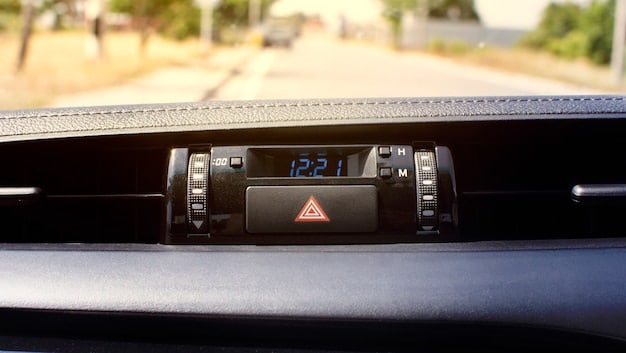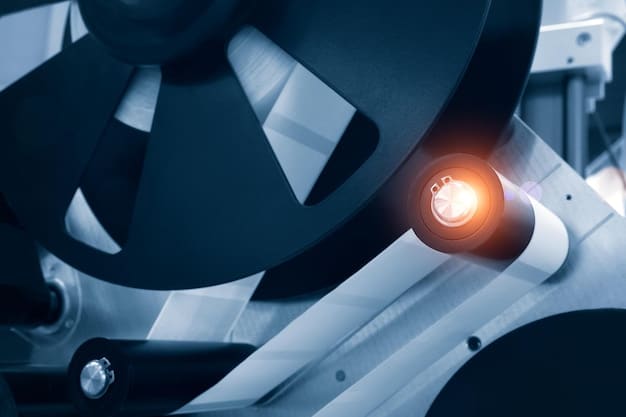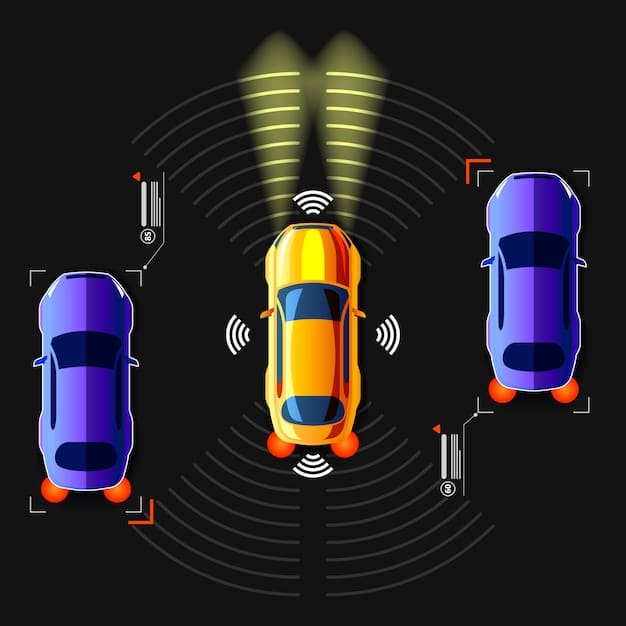How ADAS Prevents Collisions: Evolving for Safer Driving

Advanced Driver-Assistance Systems (ADAS) are rapidly evolving to prevent collisions by integrating sophisticated technologies like sensors, cameras, and radar to provide drivers with real-time alerts, automated assistance, and enhanced safety features, ultimately reducing accidents and improving road safety.
Advanced Driver-Assistance Systems (ADAS) are transforming the automotive landscape, offering a suite of technologies designed to enhance safety and prevent collisions. As technology advances, ADAS features are becoming more sophisticated and integrated, promising a future with fewer accidents and safer roads for everyone.
Understanding the Core of Advanced Driver-Assistance Systems
At its core, Advanced Driver-Assistance Systems (ADAS) represent a significant leap forward in automotive safety. These systems leverage a combination of sensors, cameras, radar, and sophisticated software algorithms to provide drivers with real-time information about their surroundings and offer automated assistance to prevent accidents.
Key Components of ADAS
The effectiveness of ADAS relies on the seamless integration of several key components that work together to perceive and respond to the driving environment.
- Sensors and Cameras: These devices act as the “eyes” and “ears” of the system, capturing visual and environmental data.
- Radar and Lidar: Radar uses radio waves, and lidar uses laser beams to detect the distance and speed of objects around the vehicle, even in adverse weather conditions.
- Central Processing Unit: This is the “brain” of the system, processing the data from the sensors and making decisions about how to respond.
- Actuators: These components carry out the decisions made by the processing unit, such as applying the brakes or steering the vehicle.
ADAS functions by collecting data, interpreting it, and then taking an appropriate course of action. This process happens in milliseconds, providing timely responses to potential hazards.

ADAS is designed to actively monitor the vehicle’s surroundings and alert the driver to potential threats. The systems automatically intervene to prevent or mitigate collisions, leading to safer driving experiences.
The Evolution of ADAS: From Warning to Intervention
Advanced Driver-Assistance Systems (ADAS) have evolved significantly over the years, transitioning from simple warning systems to sophisticated intervention technologies. This progression has been driven by advances in sensor technology, computing power, and artificial intelligence.
Early Warning Systems
Initial ADAS features primarily focused on alerting drivers to potential dangers, giving them time to react and take corrective action.
- Lane Departure Warning (LDW): Alerts the driver when the vehicle begins to drift out of its lane.
- Forward Collision Warning (FCW): Warns the driver of a potential collision with a vehicle or obstacle ahead.
- Blind Spot Monitoring (BSM): Alerts the driver when a vehicle is detected in their blind spot.
These early systems provided valuable information to drivers but relied on the driver to take appropriate action.
Modern ADAS technologies are capable of taking automated action to prevent or mitigate collisions. These intervention systems represent a significant step forward in automotive safety.
Advanced Intervention Systems
Advanced systems are now capable of taking automated action to prevent or mitigate collisions.
- Automatic Emergency Braking (AEB): Automatically applies the brakes to avoid or reduce the severity of a collision.
- Lane Keeping Assist (LKA): Automatically adjusts the steering to keep the vehicle in its lane.
- Adaptive Cruise Control (ACC): Automatically adjusts the vehicle’s speed to maintain a safe distance from the vehicle ahead.
These intervention systems greatly reduce the risk of accidents by taking immediate action when a potential hazard is detected.
Preventing Collisions: How ADAS Technologies Work Together
Advanced Driver-Assistance Systems (ADAS) prevent collisions by integrating various technologies that work together to create a comprehensive safety net around the vehicle. Each system plays a crucial role in detecting and responding to potential hazards.

By combining these technologies, ADAS creates a safer driving environment.
Specific ADAS Features and Their Impact on Collision Prevention
Let’s examine how specific ADAS features contribute to collision prevention.
- Automatic Emergency Braking (AEB): AEB uses sensors to detect potential collisions and automatically applies the brakes if the driver does not respond in time.
- Lane Keeping Assist (LKA): LKA uses cameras to monitor the vehicle’s position within its lane and provides steering assistance.
- Adaptive Cruise Control (ACC): ACC uses radar to maintain a safe distance from the vehicle ahead, automatically adjusting the vehicle’s speed.
ADAS technologies are essential for enhancing vehicle safety and preventing collisions by providing drivers with real-time information and automated assistance.
These systems contribute to a safer driving experience by reducing the likelihood of human error, which is a leading cause of accidents.
The Role of Artificial Intelligence (AI) in Enhancing ADAS
Artificial Intelligence (AI) plays a vital role in enhancing the capabilities of Advanced Driver-Assistance Systems (ADAS). AI algorithms are used to process the large amounts of data collected by ADAS sensors and make informed decisions about how to respond to potential hazards.
AI-Powered ADAS Features
AI is enabling new and improved ADAS features that were not possible with traditional technologies.
- Object Recognition: AI algorithms, such as Faster R-CNN, YOLO, and Single Shot Multibox Detector (SSD), allow ADAS to accurately identify and classify objects such as, pedestrians, cyclists, and other vehicles.
- Predictive Analytics: AI can analyze historical data to predict potential hazards before they occur, such as predicting the movement of pedestrians or the behavior of other drivers.
- Sensor Fusion: AI algorithms can integrate data from multiple sensors to create a more complete and accurate picture of the vehicle’s surroundings.
AI allows ADAS to make quicker and more accurate decisions, enhancing the safety and effectiveness of these systems.
The use of AI in ADAS has led to significant advancements in vehicle safety. By processing complex data and making intelligent decisions, AI-powered ADAS systems are helping to prevent collisions and save lives.
Challenges and Limitations of Current ADAS Technologies
Despite the significant advancements in Advanced Driver-Assistance Systems (ADAS), several challenges and limitations still need to be addressed.
Factors Affecting ADAS Performance
Factors include environmental conditions, system limitations, and human factors.
- Weather Conditions: Heavy rain, snow, or fog can impair the performance of sensors and cameras, reducing the effectiveness of ADAS features.
- System Limitations: Current ADAS technologies have limitations in detecting certain types of objects or responding to complex driving scenarios.
- Human Factors: Drivers may over-rely on ADAS features, leading to complacency or misuse of the systems.
These limitations can affect the reliability and effectiveness of ADAS in certain situations.
Addressing these is essential for realizing the full potential of ADAS in preventing collisions and improving road safety.
Continued research and development are needed to improve the reliability, robustness, and user-friendliness of ADAS technologies.
The Future of ADAS: Towards Fully Autonomous Driving
The future of Advanced Driver-Assistance Systems (ADAS) is closely linked to the development of fully autonomous vehicles. As ADAS technologies continue to advance, they are paving the way for a future where vehicles can drive themselves without human intervention.
Innovations Shaping the Future of ADAS
Several key trends and innovations are shaping the future of ADAS.
The future of ADAS is full of promise, with new technologies and innovations on the horizon that will further enhance vehicle safety and move us closer to a future of fully autonomous driving.
- Enhanced Sensor Technologies: Improved radar, lidar, and camera technologies will provide more accurate and detailed information about the vehicle’s surroundings.
- Advanced AI Algorithms: Sophisticated AI algorithms will enable ADAS to make more intelligent decisions and respond to a wider range of driving scenarios.
- Vehicle-to-Everything (V2X) Communication: V2X technology will allow vehicles to communicate with each other and with infrastructure, enabling them to share information and coordinate their movements.
These advances will enable ADAS to handle more complex driving tasks and provide drivers with a higher level of automation.
| Key Point | Brief Description |
|---|---|
| 🚨 Collision Prevention | ADAS technologies actively work to avoid accidents. |
| 🤖 Automated Assistance | Systems like AEB and LKA offer automated intervention. |
| 🧠 AI Enhancement | AI improves object recognition and predictive analytics. |
| 📡 Sensor Integration | Multiple sensors provide a comprehensive view of surroundings. |
What are the common ADAS features?
Adaptive Cruise Control (ACC), Automatic Emergency Braking (AEB), and Lane Keeping Assist (LKA) are common ADAS features.
Are ADAS systems fully autonomous?
No, ADAS systems are not fully autonomous. They provide assistance to the driver but require the driver to remain engaged and in control of the vehicle.
What are the limitations of ADAS technologies?
ADAS technologies can be limited by weather conditions, system limitations, and human factors.
How does AI enhance ADAS?
AI enhances ADAS by enabling features like object recognition, predictive analytics, and sensor fusion.
What is the future of ADAS?
The future of ADAS is closely linked to the development of fully autonomous vehicles, with new technologies and innovations on the horizon.
Conclusion
Advanced Driver-Assistance Systems are undeniably evolving into critical components for preventing collisions and enhancing overall road safety. From basic warning alerts to sophisticated intervention technologies powered by AI, ADAS promises to reduce accidents and save lives. As technology advances, continued research, development, and standardization will pave the way for safer mobility solutions.





